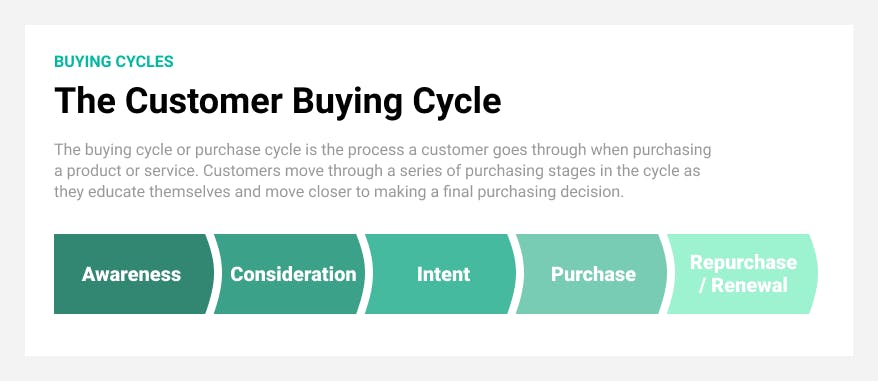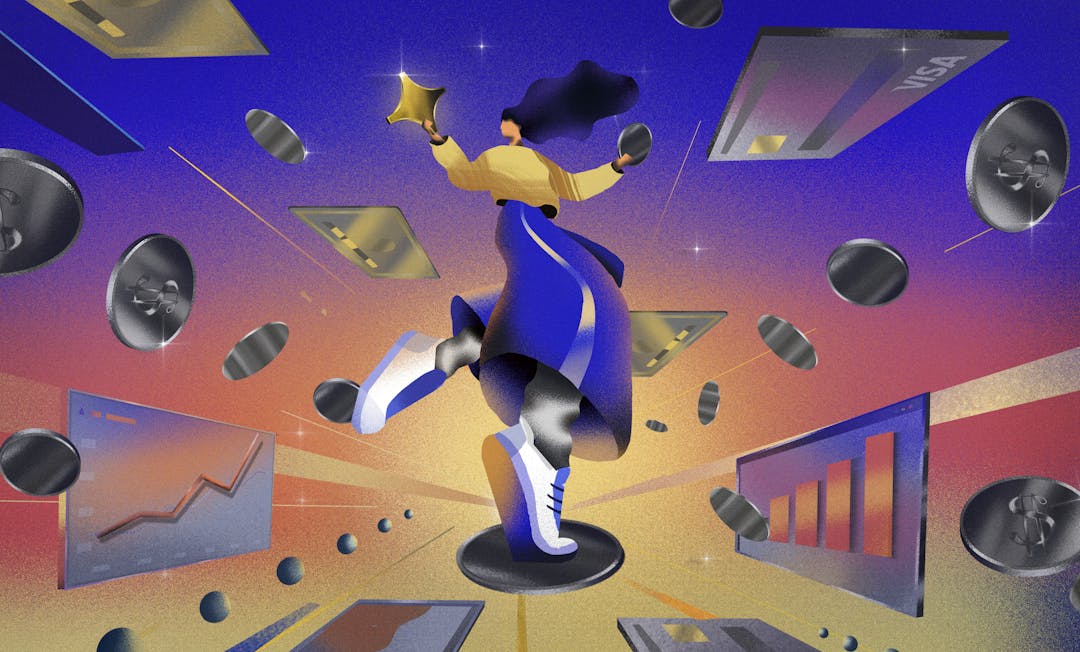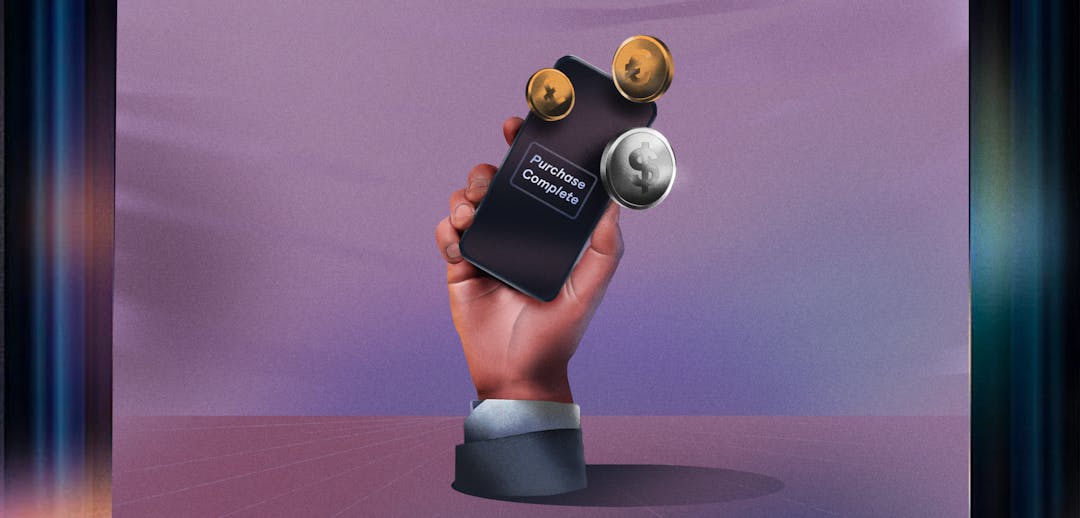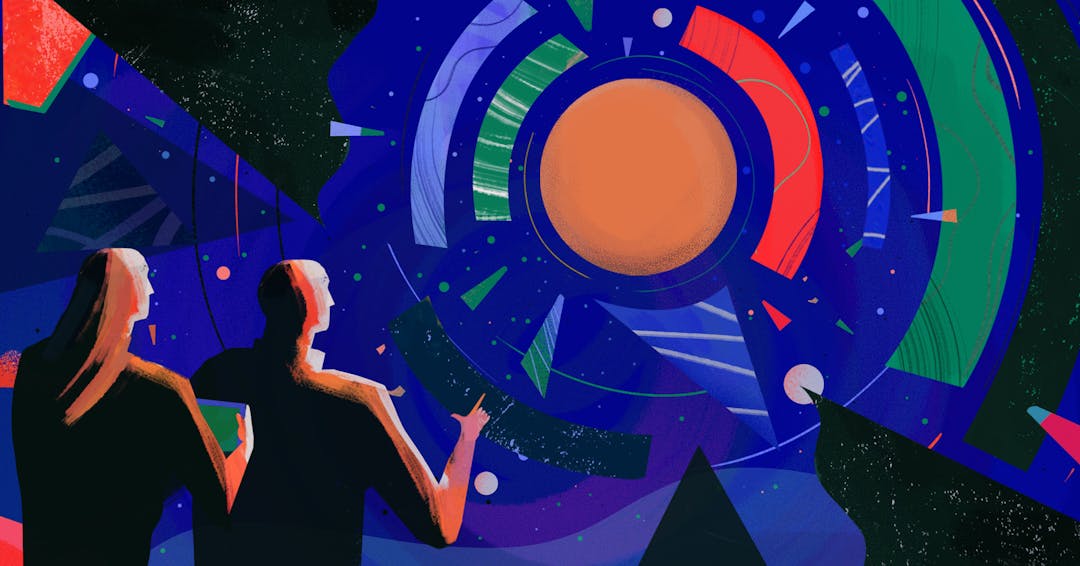The buying cycle is the process that customers go through before purchasing a product. Learn about the different stages, why the cycle matters, and how to optimize it to convert more users.
You probably have some kind of sales cycle for your product that every new customer goes through.
A process with well-defined stages, aimed at turning prospects into leads, leads into opportunities, and opportunities into customers.
Having a process in place is a great start—but if your company is like the hundreds of other SaaS companies we’ve seen, your customers don’t follow that process.
They don’t care about what they need to do to become a sales qualified lead. Instead, they act according to their own set of challenges, decisions, and budgets. They follow their own buying process, like the yin to your sales teams’ yang. The peanut butter to their jelly. You get the idea.
Understanding how your customers buy and lining up your marketing efforts, pricing, and sales process to mirror their buying process can help you increase conversions, boost retention, and decrease your cost of sales.
Failing to align your processes is also one of the most common mistakes we see most SaaS companies run into.
Let’s take a look at how you can optimize your sales process to match your customers’ buying cycle, starting with a straightforward definition of the buying cycle.

What is a buying cycle?
The buying cycle (also known as a purchase cycle) is the process a customer goes through when buying a product or service. Customers move through a series of stages in the cycle as they become problem-aware, educate themselves on solutions, and move closer to making a final purchase decision. After that decision is made, comes the question of repeat purchase.

The five buying-cycle stages
While the exact buying cycle looks a little different for every product and service, every customer goes through some process of
- realizing they have a problem;
- considering their options;
- making a decision; and
- purchasing a solution (or renewing, in the case of subscription products).
Each stage requires a different set of strategies to compel customers to move to the next stage because they expect different interactions with you depending on which stage they’re in. The goal at each stage isn’t to make the sale. Instead, your focus should be on simply moving each customer to the next stage.
And, as much as we’d like to believe we have control over which stage customers are in at any one time, they're the ones in the driver's seat. All we can do is align our strategies and sales process to match where each customer is in the purchasing cycle.
Let’s take a more detailed look at each stage in the cycle.
1. Awareness
Awareness is the first stage of the buying process. Potential customers understand they have a problem that needs solving and begin to search for solutions. It’s also the stage where companies tend to put the most effort into their marketing, since the potential for reaching new customers is only limited by the size of the market.
As soon as potential customers become aware of your product or service and how it can solve their problem, they move to the next stage in the journey: consideration.
2. Consideration
The consideration stage is where your work as the salesperson can start to make a difference. Your customer is out there searching for solutions, and your product is (hopefully) in the mix. Your job in this stage is to provide detailed information explaining how your product or service can solve their problem better than the competition and what benefits they’ll experience after solving the problem.
Once customers are convinced they need to purchase a solution for their problems—whether that means your product or your competitors’—they progress to the next stage: intent.
3. Intent
In this stage, decision-makers pit the various alternatives against each other—and whichever makes the most logical, emotional, or financial sense will be the one they end up choosing. Your sales team’s job now is to convince customers that, out of the potential solutions they might be considering, yours is the product or service they should choose.
Eventually, each customer will be ready to pull the purchase trigger and then progress to the fourth stage: purchasing.
4. Purchase
The customer has decided on the product they want to buy, and they buy it. (Hopefully, it's yours; if not, time to improve a bit!)
Even at this stage, your job isn’t done. It’s crucial to develop an ongoing relationship with customers and to support them in their problem-solving journey. Staying in close contact can also create opportunities to persuade customers to purchase again or renew their subscription—the trigger for the next stage.
5. Repurchase/Continuous Purchase
This stage can look a little different, depending on what you’re selling.
If the product you sell is perishable, like food, or consumable, like diapers, your customer will most likely be back soon for a reorder. Likewise, if you’re a subscription company, your continuous purchase point will be when a customer's billing cycle is up and they’re charged again. This stage can (and ideally will) repeat indefinitely, so it's where companies frequently find the biggest opportunities for increasing revenue.
Why buying cycles matter
Even the most successful businesses only ever convert a tiny percentage of their potential customers. The rest are still at some other stage in the buying cycle—maybe someday they’ll make it to the purchasing stage, or maybe they won’t.
Without a strong understanding of your target customers’ mind-set when buying a product, you’ll end up spinning your wheels with sales and marketing, and you’ll never capture that customer. On the flip side, seeing your products through your customers’ eyes and understanding what draws customers through each stage of the buying cycle is the path to a thriving business.
Here’s why purchase cycles should matter for your company.
Optimize your marketing efforts
View your marketing efforts through your customers’ eyes to see which aspects are working well and where your efforts will have the biggest impact.
Maybe you're getting tons of qualified traffic, but those leads aren't purchasing, indicating a problem in the consideration or intent stage. Or perhaps you discover that you’re converting nearly every lead you get, but you need to capture more leads—you should invest more time building awareness.
Either way, it’s helpful to see where your marketing efforts will have the biggest impact.
Convert more customers
When they're still trying to understand the problem they're experiencing, customers don’t like pushy salespeople. Nor do they need basic education about a solution once they're ready to make a purchase.
Understanding what customers need at each stage and then matching your sales approach to that stage directly improves your conversion rate—and keeps you from annoying customers who might not be ready to buy.
Capture a higher market share
Beyond increasing conversions with new customers, optimizing your purchase cycle can keep existing customers choosing your product or service over your competitors’, letting you capture a greater share of those customers over time.
Investing in retention analysis pays high dividends—in fact, increasing retention by just 5% can grow profits by 25% to 95%. While focusing more on the later stages of the buying cycle might mean delayed results, the increase in renewals and customer lifetime value is well worth the work and the wait.
Enough about benefits—let’s talk tactics.
Optimizing for every stage of the buying cycle
If you spend all of your time at only one end of the customer purchasing cycle—closing the sale, for example, or educating customers about their problems—you’ll fail to capture all the potential customers who are still at the other end of the cycle.
You can’t shortcut the buying process. Instead, optimize your sales and marketing efforts for every stage of the purchasing cycle.
Let’s look at what you should be doing at each stage to move customers along their buyer journey.
Awareness: marketing moves
Your marketing team has to be on this from day one. It’s incredibly important that:
- your customers know that your product exists; and
- your product will solve almost all of the problem they’re facing.
Building awareness around your product requires a strong understanding of the specific struggles your potential customers are encountering and how your product or service eases those struggles. Start by creating targeted content that helps them begin solve those problems. Then, share your content where they’ll see it, such as on social media—anywhere your future customers are already spending time.
Once potential customers engage with your content and (hopefully) sign up for your newsletter, you can use marketing automation tools to nurture them until they’re ready to progress to the consideration stage.
Consideration: tiers and options
Customers in this stage are searching for the best solutions to meet their needs, and there’s a good chance you’re not the only option available. Your first choice should once again be content—articles, case studies, and videos all educate customers about your solution and highlight reasons to choose your product rather than your competitors’.
There’s another strategy your competitors might be overlooking, though, and that’s offering multiple pricing tiers and product options. Tailor each tier to specific customer personas or budget levels. That way, every customer can find a tier that meets their needs as closely as possible. It also distinguishes your product from those of competitors who have just a single offering.
Your potential customer understands what they need, knows how your product will solve their problem, and is ready to buy a solution. Let’s look at some tactics to help close the deal.
Intent: product descriptions, reviews, and branding
Customers who reach the intent stage are ready to buy a solution. Your job now is to persuade them to buy your solution.
Success here depends more on earning trust with potential customers than educating them. Let your product speak for itself—customer reviews, case studies, and benefits lists can help sway customers to give you, rather than someone else, their credit card number. Make sure you have highlighted what your product can do that’s better than the rest, why your other customers absolutely love it, and why your brand is a sign of quality.
On the landing page, we explain how customers can integrate our analytics software with their existing system, and the benefits they'll experience by doing so. We also include social proof, like testimonials and logos from existing customers, to boost trust even further. Finally, the page has a clear CTA to sign up for a free trial, making it easy for potential customers to move to the next step: purchasing.
Purchase: optimize pricing
Your customer is ready to commit to your solution. The last thing you need is for them to change their mind at the last minute.
Make sure your pricing is accurate. Finding out at this late stage that your pricing is above (or, in some cases, far below) what they’re expecting to pay is frequently the last thing standing in the way of the sale.
For SaaS companies, the only viable option is to base pricing on value. By finding out how much customers are willing to pay for your product before they reach a purchasing decision, you’ll increase not only your conversion rate but your profitability as well. Always opt for value based-pricing to maximize your revenue.
The show doesn’t end with the purchasing decision, though—you can also improve your retention or repurchase rate with a few extra tactics.
Repurchase and renewal: customer care over everything
Whether you’re selling subscriptions or one-time purchases, growing your lifetime revenue depends much more on retaining existing customers and increasing your repurchase rate than on the number of customers who click the buy button.
Customer churn can obliterate your business when left unchecked, but shifting your focus away from marketing in the final stage in favor of customer care and product advocacy can help keep renewal rates high. Make sure customers are happy—and that they’re staying happy—by touching base regularly. As your happy customers become more experienced with your product, ask them for testimonials or case studies, or ask them to refer you to other potential customers.
You can’t shortcut the process
I see far too many founders spending all of their energy trying to close the sale—but they’re often targeting people who aren’t yet ready to make a purchase.
Trying to shortcut the buying cycle will only end in frustration and lost revenue. Instead, understanding how customers purchase your products—and how to optimize the purchasing cycle—will help you convert more customers with less effort.
Isn’t that what we all want?




